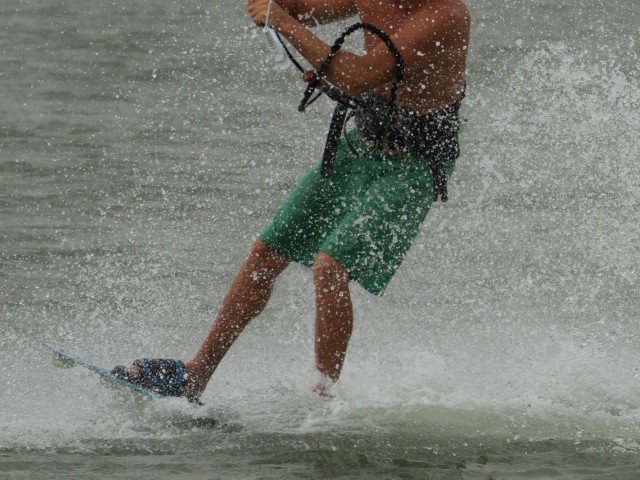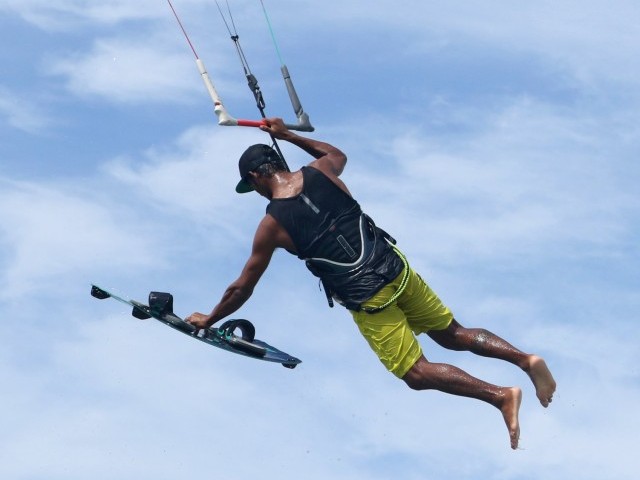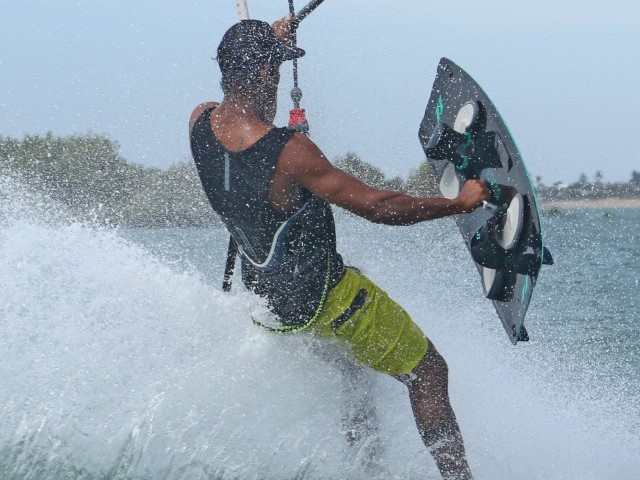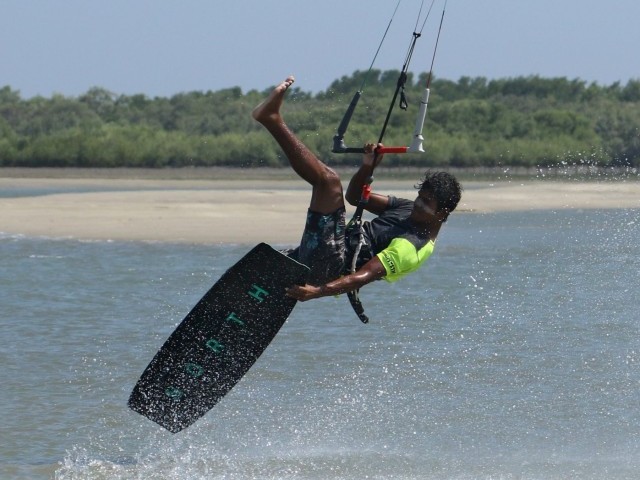
Toeside Front Loop To Blind with Ole
Technique / Advanced
Introduction
Hopefully there is a better name out there for this trick, but for the moment we’ll stick to the descriptive version. Essentially this is a pop trick, but a subtle drifting up of the kite is more than acceptable to ease you into it. For those of you confident with your toe side edge this is a great trick and an inspiring step on from the toe side pop to blind which is a good prerequisite as you need both a decent pop from your toes and the blind that very same side. If this will be a first let us recommend again that it will be easier to pop from your strong toe side to a new and unvisited blind rather than try and pop from your weaker toe side. Popping well from your pinkies is the key here.
The Approach
To pop from your toes we need two things, speed and a good solid edge. With the board fizzing over the water it’ll be a doddle to get it up and you’ll have momentum when you get it around. Looking at Pic A. you can see Christian pre pop. First off Christian has his bar trimmed in close so that he can get an aggressive edge and hold the power with two hands without being pulled up onto the board. This way he can turn his head and shoulders away from the kite and stand up onto his toes, hips forward, driving the board between him and the kite. Christian has shifted his weight back on the board ready to pop, as this will help him add tension to the lines by edging harder. However if you need more speed you must keep the front knee bent and the board trimmed flat before shifting your weight back.
The Pop
The theory behind popping is much the same as from heel side – once you have enough speed, carve up hard and stamp off the back foot. However bearing away and then carving up from toe side is no simple task, so for the same sort of effect shifting your weight back will dig the tail in and turn the board upwind on its rocker. The trick is to be quick, shift your weight back and stamp – wait and you’ll loose your speed and nothing will happen. In Pic B. Christian has leant his weight back and simultaneously drifts the kite up slightly from 11 o’clock to give himself a bit more lift whilst stamping down hard by explosively straightening his back leg. As he pops up he turns his head and shoulders down and around, initiating the front roll.
The Rotation
As with any front roll from toe side the rotation will be quick as the pull on the harness whilst toe side accelerates the movement. This is handy, as you’ll need to spin quickly to allow for the extra twist to blind. Aim to keep two hands on the bar until you are coming around the first 360˚, as this will keep you more upright and lead to a smoother landing. Looking at Pic C. as Christian reaches this point you can see that he is leading with the head. This is important, as he will know when to initiate the blind once he spots his landing. Christian also has his knees bent and board up to help encourage a quick rotation and he keeps the bar in for that little bit of extra float. As he focuses on where he’ll land he releases his back hand, turning his head and shoulders down and around under the bar so that he can get his body around to blind whilst the board is leading. This way the board will be beneath him and ready for touch down.
Throwing Blind
As a result of turning his head and shoulders down we can see in Pic D. that Christian has “thrown” the blind. As he drops his feet and board are leading the way. Whilst turning, Christian tweaks the kite down by pulling gently on his front hand. This will guarantee a bit more speed and forward momentum for the Ole, and is necessary if you sneak the kite up for take off.
Landing
As with all things Ole or pass you’ll need to land blind on a flat board heading at least a tiny bit downwind towards the kite. This way you’ll have no tension on the lines and so the Ole should be a walk in the park. Pic E. Christian lands upright over his flat board, having thrown the blind enough to land slightly off the wind. Try to keep your head up, as this will prevent you from breaking too much at the waist, which can in turn force weight onto your toes and put tension on the lines! If anything you want to be leaning on your heels. Landing this way the lines will be slack and therefore the bar will be close to you, not twisted around leading the way and pulling you over.
Ole
Landing upright on a flat board heading towards your kite sets you up perfectly for the grand finale, the Ole. Pic F. Standing over his board Christian can now push the bar upwind and around in front of him, so that the blind miraculously transforms back into toe side. Once the bar is across get both hands back on it, sheet in and ride off with a hefty grin on your face.
Top Tips
Speed, flat water and a relatively high kite will all help. Trimming your bar is mandatory, as this will both enable a good two-handed toe side and an easy Ole. Be sure to pop against the kite into the front roll, as this early tension leads to the necessary slack later on.
Follow the Sequence and Videos for a step by step and visual guide.
Common Problems
If you’re not getting enough pop from toe side try sailing more across the wind before dropping your weight back and popping.
If the kite is falling out of the sky as you land make sure that you are both popping hard into the front roll and that you give the bar a tweak forward to keep the kite from drifting too far up.
If you slide under the kite on landing try throwing your blind more aggressively by turning your head and throwing your free hand around.
If you’re getting pulled over and catching your heel side edge you’re not landing enough downwind.
If you can’t Ole and the kite pulls you over your edging on your toes whilst blind, so bake sure your weight is on both your feet, biased towards your heels.
Keystones
- Speed on your toe side edge
- Change weight to back of board and quick pop into fast rotation
- Release back hand after 360˚to throw blind
- Tweak kite forward
- Land flat and downwind
This technique article was in Issue 42 of IKSURFMAG.
Related
By Christian and Karine
Christian and Karine have been working together as a coaching team, running improver to advanced kitesurfing clinics since 2003.




























